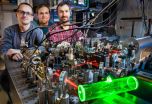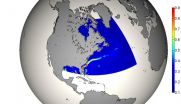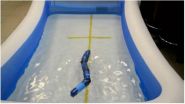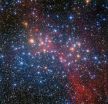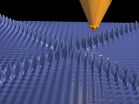(Press-News.org) This news release is available in German.
A drunken sailor staggers onto a square with lots of streetlamps on it. Sometimes he will run into one of the lamps, change his direction and keep moving. Does the time he spends on this square depend on the number of streetlamps? The surprising answer is: no.
No matter whether there is a streetlamp on every square meter or whether the distance between the lamps is large: on average, the drunken sailor will always spend the same amount of time on the square. Calculations at the Vienna University of Technology (TU Wien) have now shown that this invariance of the dwell time is a universal phenomenon. It can be observed in completely different systems - from crawling ants to light waves in disordered media.
The research on this project was carried out with collaborators Romain Pierrat, Rémi Carminati, and Sylvain Gigan from Paris (Institut Langevin and Laboratoire Kastler-Brossel), the results have now been published in the journal PNAS.
Travelling Through Imperfect Materials
Professor Stefan Rotter's team (TU Wien) analyses the propagation of waves in disordered media, such as light waves in turbid glass or quantum particles moving as a quantum wave through a material with impurities.
"Usually, such transport phenomena are characterized by the so-called mean free path", says Stefan Rotter. It is the length of the path a particle or a wave can typically travel freely until it hits the next obstacle. In the case of the drunken sailor, the mean free path would be the average distance between the street lamps. In turbid glass, it would be the distance between two microscopic impurities at which the light wave is scattered.
The Length of the Path Stays the Same
Many important physical quantities depend on the mean free path - for instance the fraction of the light, which passes through semi-transparent glass. "We can calculate how much time the transmitted part and the reflected part of the light wave spend inside the glass, respectively. These quantities, the transmission time and the reflection time, heavily depend on the mean free path", says Phillip Ambichl, PhD-student in Stefan Rotter's team and co-author of the paper.
But when those two quantities are combined to calculate the overall time the average particle or wave spends inside the medium, then the mean free path drops out of the result entirely. Quite surprisingly, light spends as much time in a turbid glass plate as in a transparent one.
It is the same with the drunken sailor: If his erratic path is blocked by an increasing number of streetlamps, there is a higher probability of the sailor hitting one of lamps right at the beginning, so that he will turn around and never venture far into the square - the time he spends on the square would thus be reduced. If, however, he happens to enter deep into the forest of streetlamps, he will be trapped there for a long time. Paths leading to the opposite side of the square thus become much longer when the number of streetlamps increases. As it turns out these two opposing effects fully compensate each other, so that the total average dwell time remains the same when changing the number of streeplamps.
"It is quite a surprise to see that this effect shows up in completely different systems", says Philipp Ambichl. "Our findings apply to rubber balls rolling across a wooden plank, hitting randomly distributed nails, as well as to electron waves travelling through a disordered system, in which the electron can be scattered at individual atoms."
Even in biology, this phenomenon can be observed: the path of ants crawling across a surface can be described as a random walk too. A large ant will traverse an area with a smaller number of steps than a small ant that will change its direction more often. But regardless of their size, the time they spend on a given area is always the same.
"With the average dwell time in an area or in a specific medium we have identified a quantity which is completely independent of the mean free path. This remarkable result will help us to better understand quite different transport phenomena appearing also in everyday applications such as in solar cells", says Stefan Rotter. Whether it is particles, waves or ants - by studying one system, one can also learn much about others, even if at first glance they may seem completely unrelated.
INFORMATION:
Link to the open access version of the published paper in PNAS: http://dx.doi.org/10.1073/pnas.1417725111
Further Information:
Prof. Stefan Rotter
Institute for Theoretical Physics
TU Wien
Wiedner Hauptstraße 8-10, 1040 Wien
T: +43-1-58801-13618
stefan.rotter@tuwien.ac.at
Neither quantum computers nor quantum cryptography will become prevalent technologies without memory systems able to manipulate quantum information easily and effectively. The Faculty of Physics at the University of Warsaw has recently made inroads into popularizing quantum information technologies by creating an atomic memory with outstanding parameters and an extremely simple construction.
Following years of tests in physics laboratories, the first quantum technologies are slowly emerging into wider applications. One example is quantum cryptography - an encryption ...
The ocean is undergoing global changes at a remarkable pace and we must change with it to attain our best possible future ocean, warns the head of The University of Western Australia's Oceans Institute.
One of the global leaders in ocean science, Professor Carlos Duarte has shared his insights on the future of the world's oceans in a paper published in the international open-access journal Frontiers in Marine Science.
In the paper Professor Duarte explains the grand challenge researchers face in addressing global change and the future state of the ocean.
"The ocean ...
This news release is available in German. Just four months after the final data package from the GOCE satellite mission was delivered, researchers are laying out a rich harvest of scientific results, with the promise of more to come. A mission of the European Space Agency (ESA), the Gravity Field and Steady-State Ocean Circulation Explorer (GOCE) provided the most accurate measurements yet of Earth's gravitational field. The GOCE Gravity Consortium, coordinated by the Technische Universität München (TUM), produced all of the mission's data products including ...
The value of a piece of chocolate cake can change. Someone who happens to be on a diet is more likely to choose a fruit dessert and judge the calorie-laden cake as unhealthy. Previous studies have shown that a specific network in the brain is active when a person must decide between various choices that vary depending on context. They emphasize the interaction between neurons in two brain areas of the prefrontal cortex - the controlling area on the front side of the brain.
Prefrontal cortex shows increased activity in all decisions
Sarah Rudorf and Todd Hare of the ...
On 24 October 2014, Sweden called off the hunt for a submarine after a week-long underwater search in the Stockholm archipelago. Triggered by a reported sighting of a Russian submarine, the alleged 'invasion' had been widely anticipated by military specialists and the media.
"Our assessment is that in the inner archipelago there was a plausible foreign underwater operation," Rear Adm. Anders Grenstad commented, "But we believe that what has violated Swedish waters has left."
"Whatever was there could not have been a conventional submarine," Grenstad said, but a "craft ...
This news release is available in Japanese.
The deep ocean seems so remote that it is difficult to imagine any sort of human-generated change making an impact on deep-sea life. It is even more difficult to collect or examine evidence from the deep ocean to determine what those impacts might be. Enter the barnacle; a hard, sessile creature that looks like a tiny volcano and attaches to rocks, boat bottoms, and other hard substrates, where it filters ocean water to feed on tiny organisms. The barnacle holds clues about how climate change is affecting the deep ocean. ...
KNOXVILLE - Warfare not only hastened human technological progress and vast social and political changes, but may have greatly contributed to the evolutionary emergence of humans' high intelligence and ability to work together toward common goals, according to a new study from the National Institute for Mathematical and Biological Synthesis (NIMBioS).
How humans evolved high intelligence, required for complex collaborative activities, despite the various costs of having a big brain has long puzzled evolutionary biologists. While the human brain represents only about two ...
Published in the journal Nature, the discovery could revolutionise fuel cells and other hydrogen-based technologies as they require a barrier that only allow protons - hydrogen atoms stripped off their electrons - to pass through.
In addition, graphene membranes could be used to sieve hydrogen gas out of the atmosphere, where it is present in minute quantities, creating the possibility of electric generators powered by air.
One-atom thick material graphene, first isolated and explored in 2004 by a team at The University of Manchester, is renowned for its barrier properties, ...
NGC 3532 is a bright open cluster located some 1300 light-years away in the constellation of Carina(The Keel of the ship Argo). It is informally known as the Wishing Well Cluster, as it resembles scattered silver coins which have been dropped into a well. It is also referred to as the Football Cluster, although how appropriate this is depends on which side of the Atlantic you live. It acquired the name because of its oval shape, which citizens of rugby-playing nations might see as resembling a rugby ball.
This very bright star cluster is easily seen with the naked eye ...
Jülich, 26 November 2014 - In metals such as copper or aluminium, so-called conduction electrons are able to move around freely, in the same way as particles in a gas or a liquid. If, however, impurities are implanted into the metal's crystal lattice, the electrons cluster together in a uniform pattern around the point of interference, resembling the ripples that occur when a stone is thrown into a pool of water. Scientists in Jülich have, with the help of computer simulations, now discovered a combination of materials that strengthens these Friedel oscillations ...

